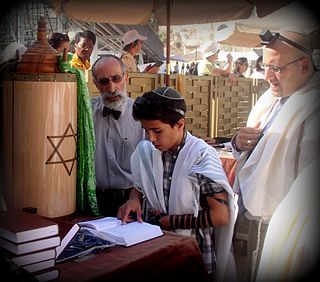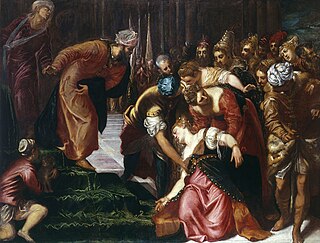Related Research Articles

The Book of Esther, also known in Hebrew as "the Scroll", is a book in the third section of the Hebrew Bible. It is one of the Five Scrolls in the Hebrew Bible and later became part of the Christian Old Testament. The book relates the story of a Jewish woman in Persia, born as Hadassah but known as Esther, who becomes queen of Persia and thwarts a genocide of her people.

The Hebrew calendar, also called the Jewish calendar, is a lunisolar calendar used today for Jewish religious observance and as an official calendar of Israel. It determines the dates of Jewish holidays and other rituals, such as yahrzeits and the schedule of public Torah readings. In Israel, it is used for religious purposes, provides a time frame for agriculture, and is an official calendar for civil holidays alongside the Gregorian calendar.

Yiddish is a West Germanic language historically spoken by Ashkenazi Jews. It originates from 9th century Central Europe, providing the nascent Ashkenazi community with a vernacular based on High German fused with many elements taken from Hebrew and to some extent Aramaic. Most varieties of Yiddish include elements of Slavic languages and the vocabulary contains traces of Romance languages. Yiddish has traditionally been written using the Hebrew alphabet; however, there are variations, including the standardized YIVO orthography that employs the Latin alphabet.

A bar mitzvah (masc.) or bat mitzvah (fem.) is a coming-of-age ritual in Judaism. According to Jewish law, before children reach a certain age, the parents are responsible for their child's actions. Once Jewish children reach that age, they are said to "become" b'nai mitzvah, at which point they begin to be held accountable for their own actions. Traditionally, the father of a bar or bat mitzvah offers thanks to God that he is no longer punished for his child's sins.

Haaretz is an Israeli newspaper. It was founded in 1918, making it the longest running newspaper currently in print in Israel. It is published in both Hebrew and English in the Berliner format. The English edition is published and sold together with The New York Times International Edition. Its Hebrew and English editions are available on the internet. In North America, it is published as a weekly newspaper, combining articles from the Friday edition with a roundup from the rest of the week. Haaretz is Israel's newspaper of record. It is known for its left-wing and liberal stances on domestic and foreign issues.

Adar is the sixth month of the civil year and the twelfth month of the religious year on the Hebrew calendar, roughly corresponding to the month of March in the Gregorian calendar. It is a month of 29 days.

Ahasuerus is a name applied in the Hebrew Bible to three rulers of Ancient Persia and to a Babylonian official in the Book of Tobit. It is a transliteration of either Xerxes I or Artaxerxes; both are names of multiple Achaemenid dynasty Persian kings.

Purim is a Jewish holiday which commemorates the saving of the Jewish people from annihilation at the hands of an official of the Achaemenid Empire named Haman, as it is recounted in the Book of Esther.
Yiddish theatre consists of plays written and performed primarily by Jews in Yiddish, the language of the Central European Ashkenazi Jewish community. The range of Yiddish theatre is broad: operetta, musical comedy, and satiric or nostalgic revues; melodrama; naturalist drama; expressionist and modernist plays. At its height, its geographical scope was comparably broad: from the late 19th century until just before World War II, professional Yiddish theatre could be found throughout the heavily Jewish areas of Eastern and East Central Europe, but also in Berlin, London, Paris, Buenos Aires and New York City.

A hamantash is an Ashkenazi Jewish triangular filled-pocket pastry associated with the Jewish holiday of Purim. The name refers to Haman, the villain in the Purim story. In Hebrew, hamantashen are also known as אוזני המן, meaning "Haman's ears". "Haman's ears" also refers to a Sephardic Purim pastry, "Orejas de Haman", thought to originate in Spain and Italy, that is made by frying twisted or rolled strips of dough.

The Israeli population is linguistically and culturally diverse. Hebrew is the country's official language, and almost the entire population speaks it either as a first language or proficiently as a second language. Its standard form, known as Modern Hebrew, is the main medium of life in Israel. Arabic is used mainly by Israel's Arab minority which comprises about one-fifth of the population. Arabic has a special status under Israeli law.
Purim Torah is humorous and satirical comments in the learned style of talmudic or halakhic comments customarily read, recited from memory or authored on or for the Jewish holiday of Purim. Purim Torah can be simple or elaborate.
Chazal or Ḥazal, an acronym for the Hebrew "Ḥakhameinu Zikhronam Liv'rakha", refers to all Jewish sages of the Mishna, Tosefta and Talmud eras, spanning from the times of the final 300 years of the Second Temple of Jerusalem until the 7th century CE, or c. 250 BCE – c. 625 CE.

The Yeshivah of Flatbush is a Modern Orthodox private Jewish day school located in the Midwood section of Brooklyn, New York. It educates students from age 2 to age 18 and includes an early childhood center, an elementary school and a secondary school.
Rabbi Hyman E. Goldin, LL.B. was a Lithuanian-American Orthodox Rabbi, attorney and Judaic scholar. A prolific author of English Jewish literature, he wrote over fifty works.
The American Israelite is an English-language Jewish newspaper published weekly in Cincinnati, Ohio. Founded in 1854 as The Israelite and assuming its present name in 1874, it is the longest-running English-language Jewish newspaper still published in the United States and the second longest-running Jewish newspaper in the world, after the London-based Jewish Chronicle.
Judaism's doctrines and texts have sometimes been associated with violence or anti-violence. Laws requiring the eradication of evil, sometimes using violent means, exist in the Jewish tradition. However, Judaism also contains peaceful texts and doctrines. There is often a juxtaposition of Judaic law and theology to violence and non-violence by groups and individuals. Attitudes and laws towards both peace and violence exist within the Jewish tradition. Throughout history, Judaism's religious texts or precepts have been used to promote as well as oppose violence.

The Times of Israel is an Israeli multi-language online newspaper that was launched in 2012. It was co-founded by Israeli journalist David Horovitz, who is also the founding editor, and American billionaire investor Seth Klarman. Based in Jerusalem, it "documents developments in Israel, the Middle East and around the Jewish world." Along with its original English site, The Times of Israel publishes in Hebrew, Arabic, French, and Persian. In addition to publishing news reports and analysis, the website hosts a multi-author blog platform.
Yom tov sheni shel galuyot, also called in short yom tov sheni, means "the second festival day in the Diaspora", and is an important concept in halakha. The concept refers to the observance of an extra day of Jewish holidays outside of the Land of Israel.

Second Purim, also called Purim Katan, is a celebratory day uniquely observed by a Jewish community or individual family to commemorate the anniversary of its deliverance from destruction, catastrophe, or an antisemitic ruler or threat. Similar to the observance of the Jewish holiday of Purim, Second Purims were typically commemorated with the reading of The Megillah about the events that led to the salvation, specially-composed prayers, a festive meal, and the giving of charity. In some cases, a fast day was held the day before. Second Purims were established by hundreds of communities in the Jewish diaspora and in the Land of Israel under foreign rule. Most Second Purims are no longer observed.
References
- 1 2 "Attacks the stokeses. .; Jewish Paper Fears Their Influence Among Jewish Children". The New York Times . July 20, 1905.
An editorial referring to ... by The Hebrew Standard
- ↑ "The Hebrew Standard".
- 1 2 "Sunday Law for Jews". The New York Times . April 16, 1887.
- ↑ "To Journey Through Life". The New York Times . November 17, 1884.
- ↑ "the Purim celebrations; Entertainments given by the young people, Recitations and Operattas Greatly Enjoyed by Large Audiences -- The Programmes Given". The New York Times . March 10, 1890.
Hebrew Standard. A violin solo by .. one of the features .. Purim Day
- ↑ "New Departures". The New York Times . December 14, 1889.
- ↑ "What the Zionists are doing in Dallas, Tex". July 31, 1908.
- ↑ "News From England". March 8, 1918.
- ↑ NJ; est. 1931